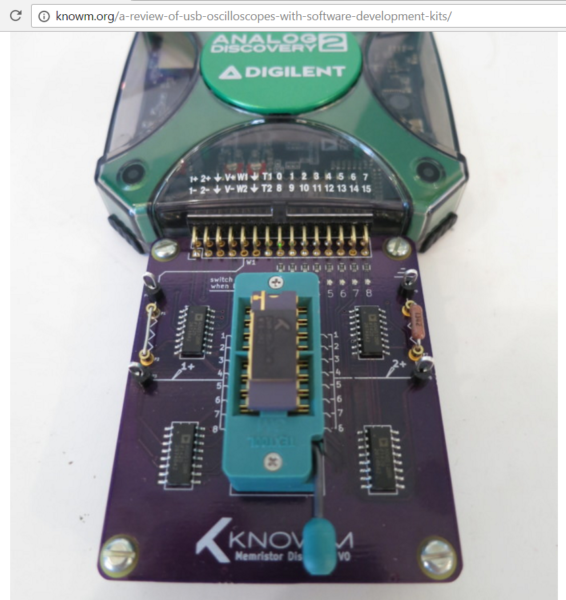Occasionally I find myself perusing the internet to find out what neat things people are doing with the Analog Discovery 2 and other Digilent products. In my last search I found KNOWM.org, which documented their process to find a USB Oscilloscope with a Software Development Kit that fit their needs. Along the way they compared 8 different devices based on signal generation and 12 different devices based on Data Acquisition. In the end they decide to order and compare use of the Red Pitaya and Analog Discovery 2.
First a little background. KNOWM.org is working on developing a new computational framework, to reduce the size and power consumption of machine learning applications. The base of these systems are memristors. Last year Tim Molter and Alex Nugent from KNOWM, began the search for a low-cost interface for people to learn how memristors work. As part of this process they compared a bunch of different USB Oscilloscopes with Software Development Kits(SDKs.)

In the post they compare Red Pitaya, PicoScope, Analog Discovery 2, Smart Scope, Bit scope, Sparkfun MiniGen – Pro Mini Signal Generator Shield, MSO19, and the HS5-110. First a comparison of specifications on the signal generators, of course including price:

Then a comparison of the Data Acquisition capabilities. This time comparing the Red Pitaya, PicoScope 2206A, Analog Discovery 2, Smart Scope, Bit Scope, Oscium, National Instruments USB-5133, Link Instruments MSO-28, Link Instruments MSO-19, TIe PieHS5-110, Analog Arts SA935, and Quant Asylum QA101:

Eventually they narrow it down to the three top contenders, the Red Pitaya, PicoScope 2206A, and the Analog Discovery 2.

In the end they decide to order the Red Pitaya and the Analog Discovery 2, and recount their purchase, and set up experience.

Once the boards arrived they go through an in depth feature comparison, highlighting the winners of each category and why. For the Waveform Generator the Analog Discovery 2 comes out victorious, because of the flexibility the BNC Adapter provides.
For the Forum and help, again the Analog Discovery 2 comes out ahead due to the quick response time on the forums.
On comparison of the Oscilloscope the Analog Discovery ends up preferable due too the higher input and output voltage ranges.
The Digital IO is deemed equivalent as both devices have the same amount of pins and same logic level.
On power supplies the Analog Discovery squeezes out the Red Pitaya due to its flexibility in voltage levels and documented power supply limitations.
They deem Red Pitaya the winner in other I/O due to the ability to communicate with SPI, I2C, an UART. It’s important to note that this has recently been added to the Analog Discovery 2 in the Protocol Analyzer.
In the next to categories, programming API and viewing I-V curves the Analog Discovery 2 again comes out ahead, due to the ease of use of the interface, and the ability to view I-V curves.
In the end, they decide to go to with the Analog Discovery 2, even creating their own adapter for memristors, and open-sourcing their Java SDK.
You can find the full review on their site, as well as more information about memristors, their memristor board and Java SDK. If you’ve done a review or comparison of our products, comment below and let us know!












Very good and useful guides Thank you.
I do not understand what this guy was comparing. This two products are actually so different that compare them is total nonsense. I have both HW and I like them both.
Red Pitaya is a fast data aquisition board with open source SW examples. The board provides all sorts of applications (from Oscilloscope, Spectrum Analyzer, Signal Generator, SDR radio….) for basic users. But their strength is not in applications they provide but in a very good HW, open source SW and its strong community. People build amazing projects from spectroscopy, radars, lidars, lasers controls, SDR radios…
Analog Discovery is on the other hand designed more as an replacement for traditional test and measurement instruments. It provides a more sophisticated Oscilloscope and Sig. Gen SW but it is on the other hand not open source.
From my point of view neither Red Pitaya nor Analog can replace traditional instruments.
Since I have instrumentation and I like making things on my own I prefer Red Pitaya because of its Open Source SW nature and very decent HW capabilities. Their instrumentation SW is not that good as of Analog Discovery but still very useful.
Hey Rolf,
The original post was comparing USB Oscilloscopes that have a Software Development Kit for writing custom applications. Although WaveForms 2015 isn’t opensource, it does provide an SDK. Sorry if I didn’t make that super clear in my summary. If you haven’t already you should check out WaveForms SDK, it might help you get more out of your Analog Discovery.
Personally, I totally agree with you that they are totally different, the AD2 is a tool that you can get up and running in a few minutes, rather than a development platform.